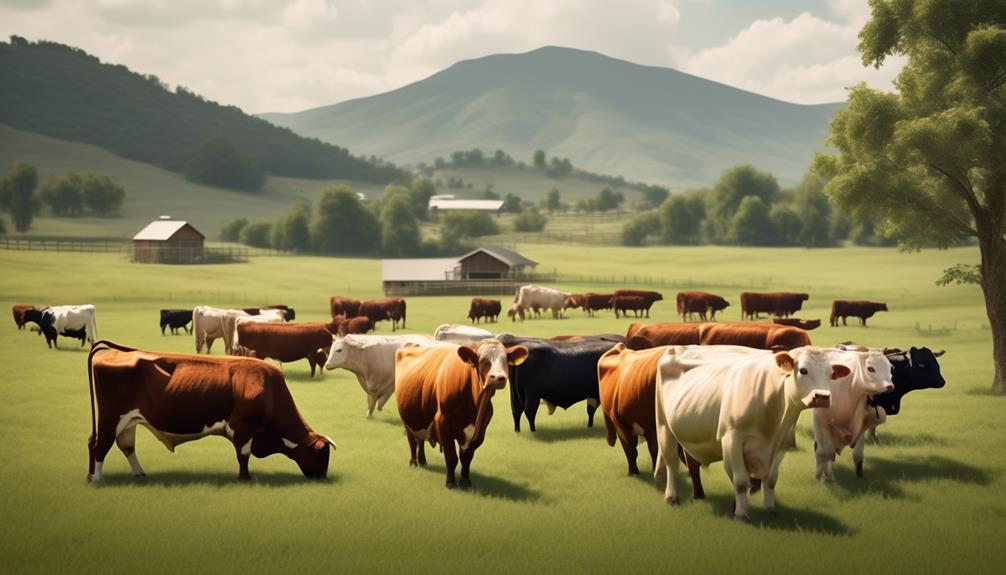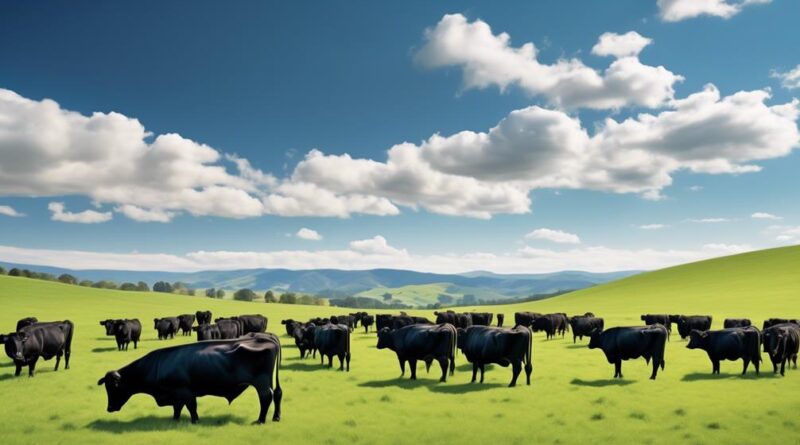4 Best Breeds for High-Quality Beef Production
When it comes to high-quality beef production, selecting the best breed is crucial for maximizing your yield and ensuring top-notch flavor. But with a myriad of breeds to choose from, how do you know which ones are the cream of the crop?
The answer lies in understanding the specific characteristics and traits that make certain breeds stand out for beef production. From marbling to flavor, each breed brings unique qualities to the table.
So, which four breeds rise above the rest in the realm of high-quality beef production?
Characteristics of High-Quality Beef Breeds
When selecting high-quality beef breeds, look for animals with a strong genetic predisposition for marbling and tenderness. These breed characteristics are crucial in determining the genetic potential of the animals for producing high-quality beef. The genetic potential of a beef breed is determined by its ability to consistently produce well-marbled and tender meat.
When considering breed characteristics, it's important to prioritize marbling, which refers to the intramuscular fat within the meat. High marbling is desirable as it enhances the flavor and juiciness of the beef. Look for breeds known for their ability to develop abundant marbling, such as Angus, Wagyu, or Hereford. These breeds possess a genetic predisposition for producing well-marbled meat, making them favorable choices for high-quality beef production.
Tenderness is another crucial factor in determining the quality of beef. Seek out breeds renowned for their tenderness, such as Wagyu and Angus, which are known for consistently producing tender meat. By selecting breeds with a genetic predisposition for tenderness, you can ensure a higher likelihood of producing beef that meets the standards for quality and flavor.
Factors to Consider in Breed Selection
Consider the specific breeding goals and production environment when selecting the ideal breed for high-quality beef production. Genetic diversity is a crucial factor to consider in breed selection. It helps in maintaining a healthy population and prevents inbreeding, which can lead to genetic defects. Different breeds bring varied genetic traits to the table, and selecting breeds with complementary traits can improve overall herd performance and quality of beef. When evaluating breeding goals, focus on traits such as growth rate, carcass quality, and maternal abilities to ensure the chosen breed aligns with the desired production outcomes.
Climate adaptability is another essential consideration. Different breeds have varying levels of adaptability to different climates. Selecting a breed that can thrive in the specific environmental conditions of your production area can lead to better animal welfare and higher productivity. It's important to assess the breed's ability to handle temperature fluctuations, humidity, and other environmental factors commonly found in your region.
Feed efficiency is a key factor that directly impacts production costs. Some breeds are more efficient at converting feed into muscle, making them more economical to raise for beef production. Evaluating a breed's feed efficiency can help optimize the use of resources and maximize profitability in beef production operations.
Top Considerations for Beef Production
To achieve high-quality beef production, prioritize selecting breeds that excel in growth rate, carcass quality, and maternal abilities to align with your production goals.
In addition to breed selection, there are several other key considerations to keep in mind for successful beef production:
- Grazing Management: Implementing effective grazing management practices is crucial for optimizing cattle health and productivity. Properly managed grazing can help maintain pasture quality, maximize forage utilization, and promote animal well-being. Rotational grazing, for example, allows forage to recover and ensures consistent nutrient intake for the cattle.
- Genetic Diversity: It's essential to prioritize genetic diversity within your herd to enhance overall resilience and adaptability. Genetic diversity can help mitigate the risk of diseases and environmental stressors, contributing to the long-term sustainability of your beef production operation. When selecting breeding stock, consider incorporating diverse genetic lines to promote a healthy and robust herd.
- Nutritional Management: Ensuring proper nutrition for your cattle is fundamental for achieving high-quality beef production. A balanced diet that meets the specific nutritional needs of different production stages is essential. Whether through pasture management or supplemental feeding, providing adequate nutrition is vital for optimal growth, reproductive performance, and overall herd health.
- Health and Welfare: Proactively managing the health and welfare of your cattle is paramount. Establishing a comprehensive herd health program, implementing vaccination protocols, and providing proper veterinary care are essential components of successful beef production. Additionally, maintaining proper housing and handling facilities promotes animal well-being and minimizes stress, ultimately contributing to improved productivity and beef quality.
Evaluating Breeds for Beef Quality
Now, let's shift our focus to evaluating breeds for beef quality, a crucial factor in achieving high-quality beef production.
When evaluating breeds for beef quality, genetic potential and carcass traits are essential considerations. Genetic potential plays a significant role in determining the quality of beef produced by a particular breed. Selecting breeds with a strong genetic potential for high-quality beef can positively impact the overall production process. It's imperative to assess the genetic background of different breeds to understand their inherent ability to yield superior beef.
Carcass traits are equally important when evaluating breeds for beef quality. These traits encompass characteristics such as marbling, tenderness, and overall meat quality. Marbling, in particular, refers to the intramuscular fat distribution within the meat, contributing to its flavor and juiciness. Tenderness, on the other hand, is a crucial aspect that directly influences the palatability of beef. Evaluating breeds based on their carcass traits enables producers to make informed decisions regarding which breeds are most suitable for high-quality beef production.
Selecting Breeds for Optimal Beef Yield
Select breeds that demonstrate high-yield potential for optimal beef production. When selecting breeds for optimal beef yield, it's essential to consider various factors to ensure the best results. Here are some key points to keep in mind:
- Genetic Diversity: Look for breeds with a wide genetic pool. Genetic diversity can contribute to improved traits such as growth rate, feed efficiency, and disease resistance. By selecting breeds with genetic diversity, you can enhance the overall productivity and resilience of your beef production.
- Environmental Adaptability: Consider the environmental conditions in which the breeds will be raised. Opt for breeds that demonstrate adaptability to the specific climate, terrain, and available resources in your region. This adaptability can lead to better weight gain, reduced stress, and overall improved performance, ultimately contributing to optimal beef yield.
- Feed Conversion Efficiency: Evaluate the feed conversion efficiency of different breeds. Choose breeds known for their ability to efficiently convert feed into muscle, as this directly impacts the yield of high-quality beef.
- Reproductive Performance: Assess the reproductive capabilities of the breeds under consideration. Breeds with good reproductive performance can contribute to a consistent and sustainable beef production system.
Best Breeds for Beef Marbling
Considering the impact on beef yield, breed selection also plays a crucial role in determining the marbling quality of the beef. When it comes to beef marbling, certain breeds have been recognized for their exceptional marbling potential. Genetic selection plays a pivotal role in enhancing the marbling quality of beef.
Among the best breeds for beef marbling, the Japanese Wagyu stands out for its renowned marbling characteristics. This breed is known for its exceptional intramuscular fat distribution, resulting in a high degree of marbling, which significantly contributes to the tenderness and flavor of the meat.
Another notable breed is the Aberdeen Angus, which is widely acclaimed for its superior marbling and meat tenderness. The breed's ability to consistently produce well-marbled beef has made it highly sought after in the industry.
Additionally, the grading system for beef marbling, such as the USDA marbling score, provides a standardized method for evaluating the marbling quality of beef. This system enables producers to assess and market beef based on its marbling attributes, ensuring a high-quality product for consumers.
Ultimately, the careful selection of breeds known for their superior marbling potential, coupled with genetic advancements and adherence to grading standards, is paramount in achieving high-quality beef with exceptional marbling.
Breed Selection for Beef Flavor

To achieve a superior beef flavor, prioritize breed selection based on their known flavor characteristics and genetic predispositions. When considering breed selection for beef flavor, it's essential to focus on specific attributes and genetic predispositions that contribute to the overall flavor profile. Here are some key factors to consider:
- Flavor Profile: Different breeds are known for distinct flavor profiles, influenced by factors such as fat content, marbling, and muscle composition. For example, Angus cattle are renowned for their rich, well-rounded flavor, while Wagyu cattle are prized for their intensely marbled beef, resulting in a buttery, melt-in-your-mouth experience.
- Genetic Predispositions: Certain breeds possess genetic predispositions that impact the beef's flavor. For instance, the genetic makeup of Hereford cattle contributes to their beef's fine-textured marbling and exceptional tenderness, enhancing the overall flavor profile.
- Sensory Evaluation: Conducting sensory evaluations of beef from various breeds can provide valuable insights into flavor characteristics. This involves assessing aspects such as aroma, tenderness, juiciness, and overall flavor intensity, allowing for informed breed selection based on desired flavor attributes.
- Consumer Preferences: Consider the preferences of the target market or consumer base. Understanding the flavor profiles preferred by consumers can guide breed selection to meet market demands and ensure high satisfaction with the beef product.
Breeds Ideal for High-Quality Beef
When striving for high-quality beef production, prioritize breed selection based on their specific attributes and genetic predispositions that contribute to superior flavor and tenderness.
Genetic diversity plays a crucial role in beef production as it helps in maintaining a healthy gene pool, reducing the risk of inherited diseases, and enhancing adaptability to different environments. When considering breeds for high-quality beef, it's essential to prioritize genetic diversity to ensure the overall resilience and sustainability of the beef production system.
Furthermore, climate adaptability is a key factor to consider when selecting breeds for high-quality beef. Different regions have varying climatic conditions, and it's important to choose breeds that can thrive in specific environments. For instance, some cattle breeds are better suited for cooler climates, while others excel in hot and arid regions.
Frequently Asked Questions
How Do Different Beef Breeds Impact the Environmental Sustainability of Beef Production?
Different beef breeds can impact environmental sustainability through breeding practices. Sustainability is affected by genetic diversity, influencing environmental impact. Consider these factors when selecting breeds for high-quality beef production.
What Are the Typical Growth Rates and Feed Conversion Ratios for the Best Beef Breeds?
When considering breed performance and genetic selection for high-quality beef, it's important to look at feed efficiency and growth rates. Different breeds have varying feed conversion ratios and growth rates, so select carefully for optimal production.
Are There Any Specific Health Considerations or Common Diseases Associated With Certain Beef Breeds?
When considering beef breeds, it's important to understand genetic predispositions and breeding strategies for disease resistance. Implementing effective health management practices can help mitigate common diseases associated with certain breeds in your operation.
How Do Different Beef Breeds Handle Stress and Adapt to Varying Climates and Environments?
Different beef breeds handle stress differently. Some have high stress tolerance and adapt well to varying climates. When choosing breeds, consider genetic diversity for climate adaptation. Selecting the right breed is crucial for successful beef production.
What Are the Typical Market Demands and Consumer Preferences for Beef From Different Breeds?
When it comes to beef, consumer preferences and market demands play a crucial role. Understanding genetic diversity and breed selection can help you meet these demands effectively, ensuring high-quality beef that resonates with consumers.
Conclusion
So, when it comes to high-quality beef production, the best breeds to consider are Angus, Hereford, Wagyu, and Charolais. These breeds are known for their excellent marbling, flavor, and optimal beef yield.
By evaluating these factors and selecting the right breed for your production needs, you can ensure that you're producing top-quality beef for your customers and maximizing your business's success.
